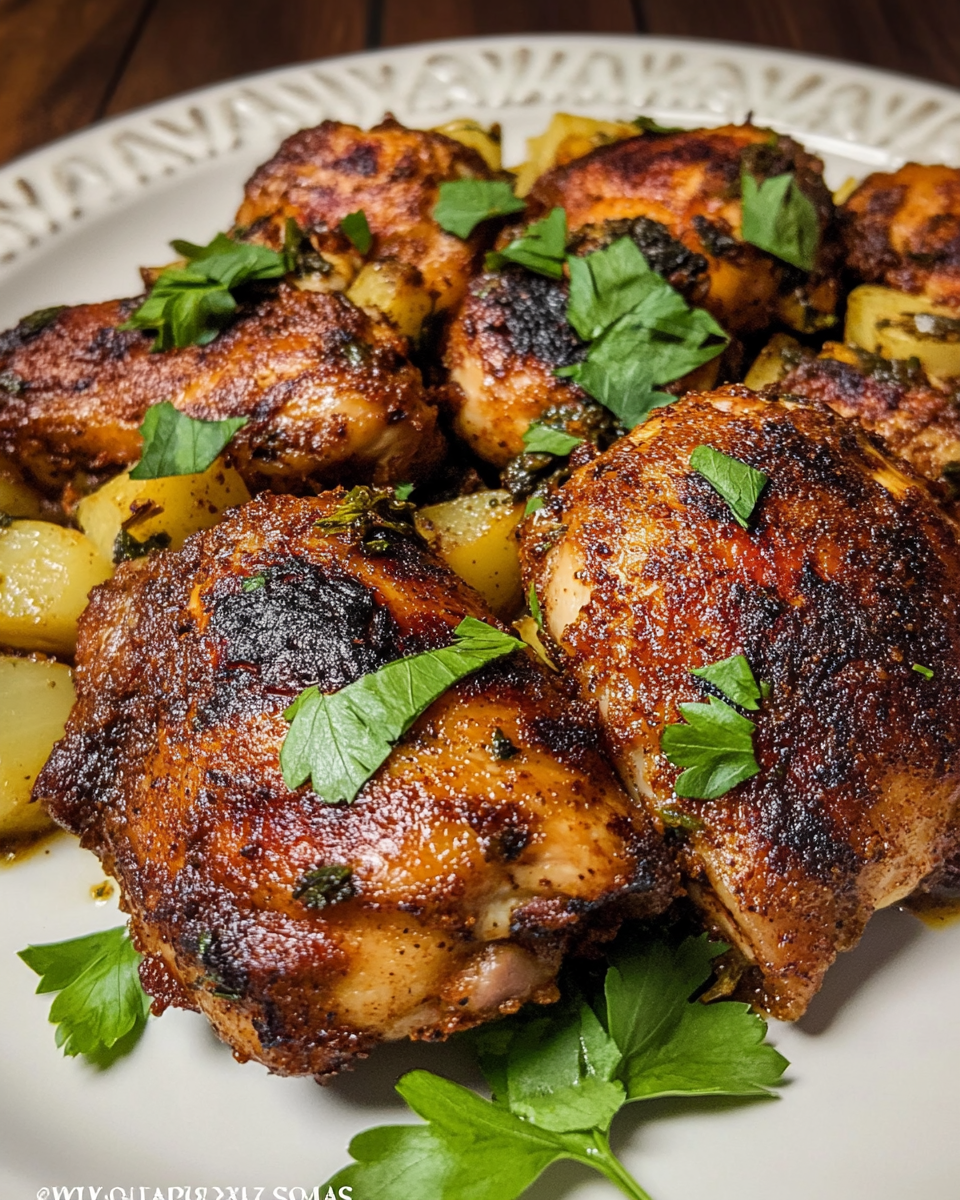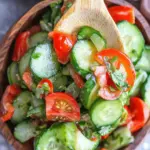The fragrant spices of cumin, coriander, cinnamon, and paprika dance together in this Moroccan-inspired chicken dish, delivering bold, complex flavor in every bite. Roasted to juicy perfection, the chicken thighs are infused with citrus and ginger, providing a fresh, aromatic finish. This meal is perfect for busy weeknights when you want something quick yet impressive. Serve it with couscous, rice, or a fresh salad for a full Moroccan-style spread. The dish also keeps well, making it ideal for meal prep or next-day leftovers that taste even better.
Full recipe:
Ingredients:
-
6 bone-in, skin-on chicken thighs
-
2 tablespoons olive oil
-
1 teaspoon ground cumin
-
1 teaspoon ground coriander
-
1 teaspoon paprika
-
1/2 teaspoon ground cinnamon
-
1/4 teaspoon cayenne pepper
-
1 teaspoon kosher salt
-
1/2 teaspoon black pepper
-
1 tablespoon brown sugar
-
1 tablespoon lemon zest
-
2 tablespoons lemon juice
-
1 tablespoon orange juice
-
1 teaspoon fresh grated ginger
-
4 cloves garlic, minced
-
1 small red onion, sliced
-
1/4 cup chopped fresh cilantro (optional garnish)
-
Lemon wedges, for serving
Directions:
-
Preheat the oven to 400°F (200°C).
-
In a small bowl, mix cumin, coriander, paprika, cinnamon, cayenne, salt, pepper, brown sugar, lemon zest, lemon juice, orange juice, ginger, and garlic into a thick marinade.
-
Pat chicken thighs dry with paper towels. Place them in a large bowl or resealable plastic bag.
-
Pour the marinade over the chicken and rub it thoroughly to coat. Let sit at room temperature for 30 minutes, or cover and refrigerate up to 24 hours.
-
In an ovenproof skillet, heat olive oil over medium-high heat.
-
Add chicken thighs, skin side down, and sear for 4–5 minutes until golden brown. Flip and sear the other side for 2–3 minutes.
-
Add sliced red onions around the chicken. Transfer skillet to the oven and roast for 20–25 minutes, or until the chicken reaches an internal temperature of 165°F (74°C).
-
Let rest for 5 minutes, garnish with cilantro and serve with lemon wedges.
Prep Time: 15 minutes | Cooking Time: 35 minutes | Total Time: 50 minutes
Kcal: 360 kcal | Servings: 4 servings
Origins of Moroccan Spiced Chicken
Moroccan cuisine is deeply rooted in the traditions of Berber, Arab, and Mediterranean culinary influences. Over the centuries, Morocco’s geographic location and history as a trading hub introduced an array of spices to its kitchens—cumin, coriander, cinnamon, ginger, paprika, and turmeric, to name a few. These spices were not only used for their bold flavor but also for their health benefits and preserving properties.
Moroccan Spiced Chicken is a classic example of this rich culinary tapestry. It captures the warm, aromatic essence of Moroccan flavors in a dish that is simple to prepare yet deeply complex in taste. The use of citrus like lemon and orange juice balances the warmth of the spices, adding brightness and a hint of tanginess. It’s a dish often served at family gatherings, weddings, and holiday meals, highlighting its cultural significance as a symbol of hospitality and abundance.
Why Moroccan Spiced Chicken Is So Flavorful
What sets this dish apart is its harmonious balance of spices. You’re not just tasting heat or sweetness; you’re experiencing layers—savory from the cumin and coriander, warmth from the cinnamon, heat from the cayenne, and brightness from lemon and ginger. The spices not only season the meat but also help tenderize it when used in a marinade. The brown sugar helps with caramelization, giving the chicken a beautiful golden-brown skin when roasted.
Furthermore, by searing the chicken before roasting, you lock in juices and develop deep umami flavors from the Maillard reaction. The red onions absorb the drippings and spices in the pan, becoming soft and sweet, almost jammy, making them a perfect complement to the tender meat.
Health Benefits of This Dish
Moroccan Spiced Chicken is as nutritious as it is delicious. Chicken thighs, especially when bone-in and skin-on, are rich in protein, zinc, iron, and B vitamins, all essential for energy metabolism and immune support. While chicken thighs have more fat than breasts, they offer better flavor and moisture—making them a better choice for roasting.
The spices used carry their own health perks:
- Cumin: Known to aid digestion and reduce inflammation.
- Coriander: May help lower blood sugar levels and improve heart health.
- Ginger and garlic: Have antimicrobial properties and support immune health.
- Cinnamon: Can help with blood sugar regulation and offers antioxidants.
By using olive oil instead of butter or vegetable oils, you’re incorporating healthy fats that support heart and brain health. The optional garnish of cilantro is rich in vitamin K and antioxidants, while citrus juices provide vitamin C, aiding iron absorption from the chicken.
Perfect for Meal Prep and Entertaining
This recipe isn’t just ideal for a flavorful weeknight dinner—it’s also fantastic for meal prep or entertaining guests. Once cooked, the chicken stays moist for days in the fridge, and its flavor actually deepens as the spices continue to infuse the meat. It can be served cold over salads, reheated for quick lunches, or shredded into wraps or rice bowls.
For hosting, Moroccan Spiced Chicken offers a wow factor without requiring professional chef skills. It pairs beautifully with simple sides like couscous, roasted root vegetables, or a fresh cucumber salad. Add a glass of mint tea or a citrusy white wine, and you’ve got a restaurant-quality experience right at home.
Flexible and Easily Customizable
One of the best features of this dish is how easily it adapts to dietary preferences and pantry availability. Want to go low-carb? Pair it with cauliflower rice or zucchini noodles. Avoiding heat? Reduce or omit the cayenne pepper. Need a dairy-free option? This recipe already qualifies. Don’t have chicken thighs? Substitute with chicken breasts or drumsticks—just adjust the cooking time to avoid drying out.
You can also elevate it by adding olives, preserved lemon, or golden raisins for more Moroccan flair. Serve it with yogurt or tahini-based sauces to add creaminess and contrast to the spices.
Time-Saving and Beginner-Friendly
Despite its complex flavor profile, Moroccan Spiced Chicken is incredibly beginner-friendly. The entire marinade comes together in a single bowl, and the searing-and-roasting method is nearly foolproof. It’s a one-pan wonder that limits cleanup while maximizing taste.
This makes it an ideal dish for home cooks who want to expand their flavor palette without diving into overly complicated techniques. It’s especially helpful for those who are new to spice blends or intimidated by international cooking.
A Family-Friendly Dish
Kids and adults alike love the rich, warming flavors of this dish. The brown sugar adds a mild sweetness that balances the spices, making it accessible even to those who don’t normally enjoy spicy foods. It’s also an excellent way to introduce young palates to global cuisine, helping build taste memory and culinary curiosity.
Many families have adopted Moroccan Spiced Chicken into their regular dinner rotation because it’s satisfying, nutrient-dense, and feels like a special treat without requiring much effort.
Why This Recipe Stands Out Among Chicken Dishes
While there are countless chicken recipes out there, this one truly stands out because it brings restaurant-quality flavors into the comfort of your own kitchen. It offers the depth and satisfaction of slow-cooked food, but it’s ready in under an hour. It celebrates spice without overwhelming the palate, making it suitable for a wide audience.
Moreover, it’s a recipe that tells a story—with every bite, you’re tasting centuries of North African culinary tradition. It’s not just food; it’s culture, history, and nourishment combined.
Pairing Ideas and Serving Suggestions
Here are a few ideas to round out your Moroccan meal:
- Grain Sides: Serve with couscous, pearl barley, or saffron rice.
- Vegetables: Roasted carrots with cumin, sautéed greens, or grilled zucchini complement the spice blend well.
- Flatbreads: A warm piece of naan or pita is perfect for scooping up juices.
- Sauces: Add a dollop of harissa or a drizzle of lemon-tahini sauce.
- Salads: A cucumber-tomato salad with a mint vinaigrette offers cooling contrast.
Conclusion
Moroccan Spiced Chicken is more than just a meal—it’s a flavor journey. It’s a dish that checks all the boxes: quick, affordable, healthy, impressive, and deeply satisfying. Whether you’re cooking for yourself, your family, or friends, it offers a way to bring something vibrant and worldly to your table without leaving your kitchen.






